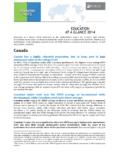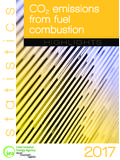Transcription of Korea - OECD.org - OECD
1 Education at a Glance: OECD Indicators is the authoritative source for accurate and relevant information on the state of education around the world. It provides data on the structure, finances and performance of the education systems in the 34 OECD member countries, as well as a number of G20 and partner countries. Korea Korea has a huge educational gap between the younger and older generations. In 2012, more Korean adults had attained tertiary education than had attained only an upper secondary education. Since 2000, the share of Koreans aged 25-64 who have attained a tertiary education has increased by 18 percentage points to 42%, the fifth highest share among OECD countries (OECD average: 32%). Among those aged 25-34 years old, 66% held a tertiary qualification, the highest share among OECD countries, compared with an average of 39%. In this age group, Korea ranks first for both men (62%) and women (69%).
2 However, Korea has the highest gap in education attainment between young adults and the older generation. The gap in tertiary attainment rates between 25-34 year-olds and 55-64 year-olds was 52 percentage points in 2012, compared with an OECD average of 15 percentage points. For example, only 8% of Korean women aged 55-64 hold a tertiary qualification, the second lowest rate among all OECD countries, higher only than Turkey. This gap reflects a high degree of upward intergenerational mobility in education in 2012, the second-highest among OECD countries. More than 58% of Korean adults attained higher levels of education than their parents (absolute upward mobility), compared with the OECD average of 39%. Only Finland and the Russian Federation also have upward mobility rates above 50%. Korean men were considerably more upwardly mobile than women, with 62% attaining higher levels of education than their parents, compared with 53% of women.
3 Despite strong PISA results, there is room to improve the skills of Korean adults. Korea remains one of the top performers in PISA. Almost one in three Korean 15-year-old students reached the highest level in mathematics, the greatest share among all OECD countries. Between 2003 and 2012, Korea saw around a 6 percentage point increase in the share of students performing at or above Level 5, the highest increase among OECD countries except Poland. However, the level of skills among the Korean adult population remains low compared with other countries participating in the Survey of Adult This survey assessed the proficiency of adults in literacy and numeracy skills, from Level 1 (lower level of skills) to 5 (higher level of skills). Korean adults (25-64 year-olds) scored 269 on average in literacy for all levels of education combined, and 261 in numeracy, both just under the averages for OECD countries. As with educational attainment, there is a generational gap in proficiency levels for these foundation skills in Korea .
4 Adults 1 The Survey of Adult Skills is a product of the OECD Programme for the International Assessment of Adult Competencies (PIAAC). Korea Country Note Education at a Glance 2014: OECD Indicators OECD aged 55-64 years old scored 45 points lower in mean literacy and 48 points lower in numeracy than those aged 25-34; this is the highest gap among OECD countries. Korea also ranks low among tertiary-educated adults aged 25-64 years old, scoring 291 in mean literacy compared with top-scoring countries Japan, with 314, and Finland, with 309. Around 14% of tertiary-educated Koreans aged 25-64 years old scored Level 4 or 5, compared with an OECD average of 24%. Korea continues to spend heavily on education, but the share of private expenditure is higher than the OECD average. Total expenditure on educational institutions in Korea for all levels of education was the third highest among OECD countries, about 8% of GDP in 2011, compared with 6% on average for OECD countries overall.
5 The share of private expenditure in Korea was also among the highest, especially at the tertiary level: 73% of spending on tertiary education came from private sources in 2011, compared with an OECD average of 31%. By contrast, annual public expenditure per student on tertiary educational institutions (USD 3 076) was much lower than the OECD average of USD 9 221. Other findings A growing share of 25-64 year-olds participated in formal and/or non-formal-education, reaching 50% in 2012, similar to the OECD average. The main reason given for not engaging in more/any learning activity was I was too busy at work (46%, compared with the OECD average of 30%). As in most OECD countries, participation was higher among those with higher skill levels and higher educational attainment, and higher among the employed than the unemployed. Korean teachers in public institutions spend comparatively less time on teaching: in 2012, on average they spent about 583 hours teaching per year at the pre-primary level and 568 hours at the lower secondary level.
6 By comparison, the OECD averages are 979 hours and 691 hours respectively. At the upper secondary level, Korean teachers spent 549 hours teaching per year, compared with an OECD average of 655 hours. The proportion of Korean adults (25-64 year-olds) reporting that they are in good health was the lowest by all levels of educational attainment and all literacy proficiency levels in 2012. This work is published under the responsibility of the Secretary-General of the OECD. The opinions expressed and arguments employed herein do not necessarily reflect the official views of OECD member countries. This document and any map included herein are without prejudice to the status of or sovereignty over any territory, to the delimitation of international frontiers and boundaries and to the name of any territory, city or area. For more information on Education at a Glance 2014 and to access the full set of indicators, visit Questions can be directed to: Corinne Heckmann Directorate for Education and Skills Email: Country Note author: Shinyoung Jeon Directorate for Education and Skills Email.
7 Key Facts for Korea in Education at a Glance 2014 TableIndicator Rank among OECD countries and partner countries*Enrolment rates20122005201220053-year-olds (in early childhood education)85%m70%64%14 of 374-year-olds (in early childhood and primary education)87%m84%79%24 of year-olds (all levels)99%98%18 of 44 Percentage of population that has only attained below upper secondary year-olds18%32%24%34%21 of 36 Percentage of the population whose highest level of attainment is upper secondary year-olds41%44%44%44%22 of 37 Percentage of population that has attained tertiary education201220002012200025-64 year-olds42%24%33%22%6 of 3725-34 year-olds66%37%40%26% 1 of 3655-64 year-olds14%9%25%15% 29 of 36 Entry rates into tertiary education2012200020122000 Youth expected to enter tertiary-type A programmes before turning 2557%m48%m7 of 35 Graduation of today s young people expected to complete upper secondary education in their lifetime92%96%84%76%12 of of today s young people expected to complete university education (tertiary-type A)
8 In their lifetimemm38%28%Unemployment rate of 25-64 year-olds - Men and Women2012200820122008 Below upper secondary3%2%14%9%35 of 35 Upper secondary and post-secondary non-tertiary3%3%8%5%35 of 36 Tertiary3%3%5%3%29 of 36 Unemployment rate of 25-64 year-olds - Women2012200820122008 Below upper secondary2%2%13%9%35 of 35 Upper secondary and post-secondary non-tertiary2%2%9%6%34 of 35 Tertiary3%2%5%4%31 of 35 Average earnings advantage for 25-64 year-olds with tertiary education** Men and women22 of 33 Men26 of 33 Women25 of 34 Average earnings penalty for 25-64 year-olds who have not attained upper secondary education**Men and women24 of 33 Men21 of 33 Women13 of 34 Percentage of 15-29 year-olds neither employed nor in education or training, by highest level of education2012200820122008 Below upper secondarymm15%14%Upper secondarymm16%14%Tertiarymm13%11% (Web)2012 or latest year available2012 or latest year (Web) (Web) and Labour Market (Web)2012 or latest year available2012 or latest year availableKoreaOECD averageEducational Access and Facts for Korea in Education at a Glance 2014 TableIndicator Rank among OECD countries and partner countries*KoreaOECD averageAnnual expenditure per student (in equivalent USD, using PPPs)Pre-primary education14 of 36 Primary education22 of 38 Secondary education23 of 38 Tertiary education23 of 37 Total expenditure on educational institutions as a percentage of of GDP8%6%6%5%3 of 37 Total public expenditure on a percentage of total public expenditure16%17%13%13%5 of 34 Share of private expenditure on educational education 4 of , secondary and post-secondary non-tertiary education3 of education2 of levels of education2 of 33 Ratio of students to teaching staffPre-primary education12 of 31 Primary education10 of 36 Secondary education7 of 37 Number of hours of teaching time per year (for teachers in public institutions)
9 2012200020122000 Pre-primary education583100127 of 28 Primary education69486578278023 of 33 Lower secondary education56857069469729 of 33 Upper secondary education54953065562826 of 33 Index of change in statutory teachers salaries for teachers with 15 years of experience/minimum training (2005 = 100)2012200820122008 Primary school teachers959910310321 of 26 Lower secondary school teachers969910210319 of 25 Upper secondary school teachers969910110318 of 25 Ratio of teachers salaries to earnings for full-time, full-year adult workers with tertiary educationPre-primary school teachers1 of 25 Primary school teachers1 of 28 Lower secondary school teachers1 of 28 Upper secondary school teachers1 of 28 Average of countries with available data20129%37%55% (L)51%* Countries are ranked in descending order of values.** Compared to people with upper secondary education; upper secondary = Survey of Adult Skills is a product of the OECD Programme for the International Assessment of Adult Competenciesm': data is not available.
10 'n': magnitude is either negligible or zero. 'c': there are too few observations to provide reliable in formal and non-formal education201225-64 year-olds 50%New data from the Survey of Adult SkillsKoreaStudents in tertiary (20-34 year-olds) parents have not attained upper secondary education10%..whose parents have an upper secondary education43%..whose parents have a tertiary education and Teachers2012201219%9%73%31%99271395846%1 9% Investment in Education20112011











